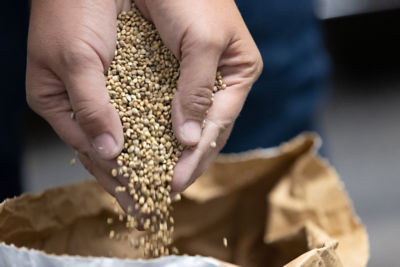Causal Agent
Pythium spp., Rhizoctonia solani, Acremonium spp., Fusarium equiseti, and other fungi.
Distribution
Worldwide
Symptoms
Pre-emergence damping-off: Seeds may rot before germinating or seedlings may die prior to emergence.
Post-emergence damping-off: Young seedlings develop a rot at the crown; later, the tissue becomes soft and constricted and the plants wilt and fall over.
Pythium spp.: Seedlings turn dull green and cotyledons droop. Water-soaked lesions develop on the hypocotyls at the soil line and seedlings wilt and collapse. Seedlings may also rot in the soil before emergence.
Rhizoctonia solani: This fungus can infect seed, preventing germination. Symptoms on young seedlings are similar to those caused by Pythium species. On older seedlings, a depressed tan to reddish-brown dry lesion may be observed on the hypocotyl.
Acremonium spp.: Symptoms develop 7–10 days after seedlings emerge. Infection begins where the seed coat remains attached to the hypocotyl. This area turns a light yellow-brown color. Within two to three days a dry red-brown rot develops, which may lead to seedling death. Surviving seedlings remain stunted.
Fusarium equiseti: A dry, reddish-brown rot occurs on the hypocotyl. The fungus causes both pre- and post-emergence damping-off.
Thielaviopsis basicola: Lesions begin as grey to reddish areas that almost immediately turn coal black in color. In wet soil, a frosty coating may cover parts of the black lesion.
 Watermelon seedlings infected with Thielaviopsis basicola. (Courtesy of Gerald Holmes)
Watermelon seedlings infected with Thielaviopsis basicola. (Courtesy of Gerald Holmes)
Conditions for Development
Damping-off is generally most severe under conditions of high soil moisture and/ or compaction, overcrowding, poor ventilation and cool, damp, cloudy weather. In addition, Acremonium root rot is favored by deep planting. Fusarium equiseti attacks melons which have been seeded into cool, moist soil which later crusts around or over the hypocotyls. Seedlings are most susceptible to damping-off prior to emergence or within the first week after emergence. In greenhouses, incompletely pasteurized soil is common source of damping-off fungi and overwatering commonly exacerbates damping-off.
Control
Open Field: In addition to the greenhouse measures described above, avoid soil compaction, prepare high beds to obtain better drainage and avoid long irrigation periods. Acremonium root rot can also be minimized by shallow planting in dry soil followed by irrigation.
Protected Culture: Ensure that substrate/soil consists of components which favor drainage and aeration. Use a reputable substrate/soil supplier. Implement sanitation measures for supplies and equipment. Manage irrigation practices to avoid long periods of high soil moisture. Use high quality seed to help reduce damping-off. Fungicidal soil drenches and seed treatments are available that help manage damping-off. The use of a biological control agent (e.g., Trichoderma harzianum) has been shown to be effective in controlling damping-off pathogens in various cucurbits.



